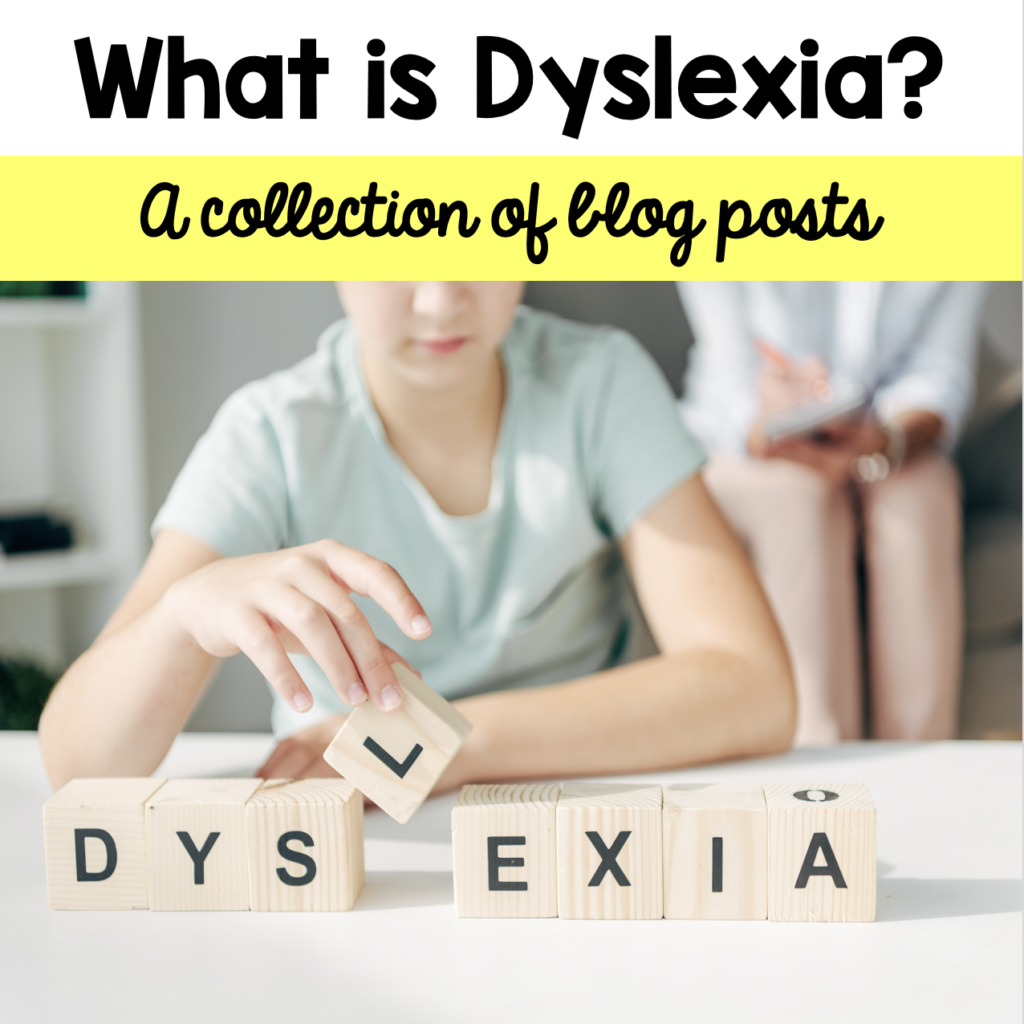Hello! I’m finally writing about the topic I’m most passionate about in education: Dyslexia. This is just one of a series of posts about dyslexia because there is SO much to share. I thought I’d start with dyslexia myths and misconceptions because there are so many out there. In order to understand what dyslexia really is, we need to know what it is NOT.
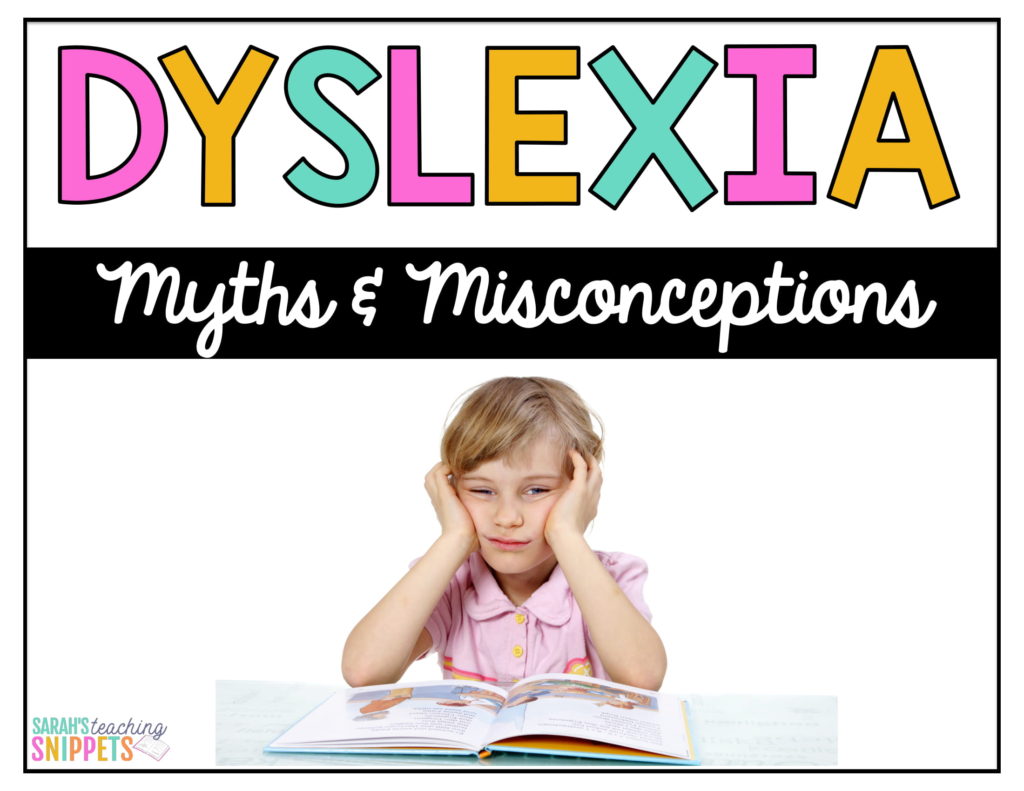
I hope to shed some light on this topic for you because these students ARE in your class. They were there last year and the year before that. You might not have identified them, but they are there. I think back to all of the students that I never identified because I didn’t have this information. I hope to spread knowledge so we can together make a difference in the lives of these students and maybe, someday, in the education system.
This quote from Sally Shaywitz, author of Overcoming Dyslexia, is very powerful and sadly, so true:
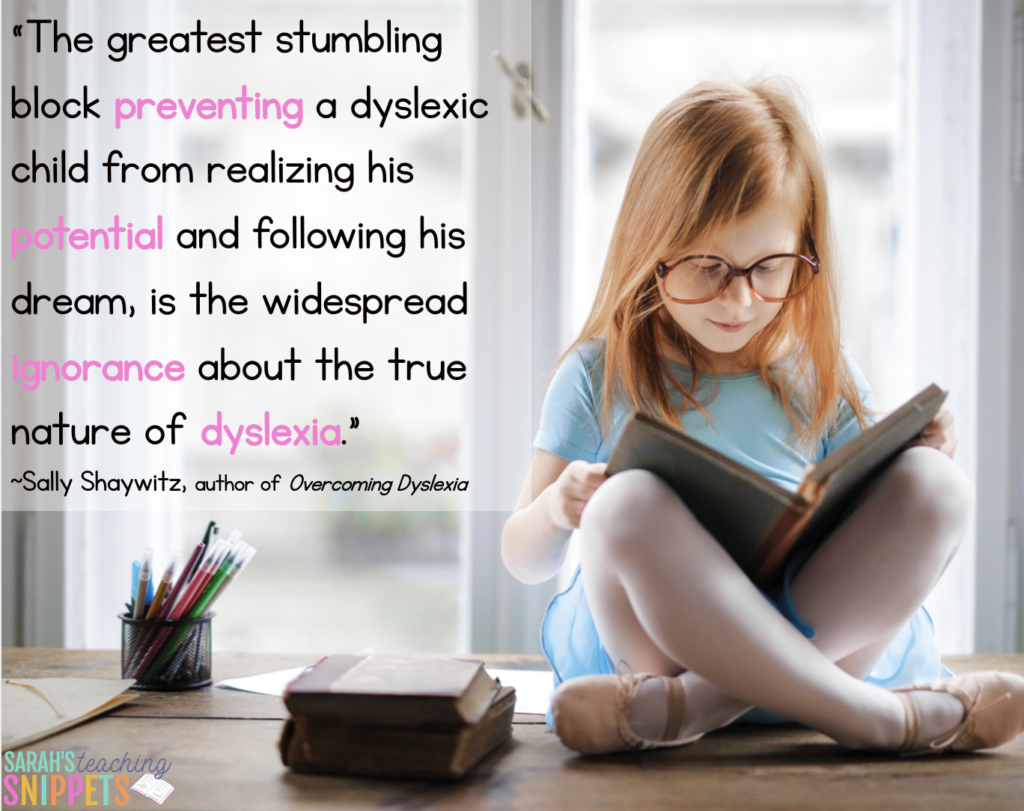
Dyslexia Myth #1:
People with dyslexia read backward.
This is the most common thing that I hear, tied with the next one. Here’s the truth:
- Dyslexics do not see things backward.
- Dyslexia is not a vision problem that can be solved with vision therapy.
- There is actually no evidence that suggests that dyslexics see things backward.
- There IS evidence that dyslexics have trouble processing and manipulating the sounds in words.
So why do so many children with dyslexia reverse b’s and d’s?
- First of all, reversals are normal through first grade. Beyond that, it may be a red flag.
- Secondly, not all dyslexics have issues with reversals. However, I would say there is a common correlation, though. Just be careful not to define dyslexia as a “reversal thing.”
Reversals are actually the result of the brain trying to process directionality.
- Before kids enter school and start learning to read, they are surrounded by objects that are still those objects no matter which way you turn it.
- For example, their favorite stuffed bear is still a stuffed bear no matter which way you turn or flip it.
- My mentor, Barbara Steinberg, gave the example of a chair. When you flip it upside down, is it still a chair? Yes! If you turn it to face you and then turn it so it’s not facing you, is it still a chair? Yes! How about a “b”? If you flip it, is it still a “b”? No!
- Letters are the first time we ask kids to notice that directionality. The brain needs to be trained that a circle and a stick can be a b or a d or a p or q based on which was its oriented. Some kids can do this quickly and it takes other kids longer.
So yes, there are many children with dyslexia who have a hard time with reversals, but there are many who do not.
Dyslexia Myth #2:
Dyslexia is when kids write their b’s and d’s backward.
This falls under the first one, but it is worth making its own category since it is such a common misunderstanding. Reversing letters is actually a normal part of development through 2nd grade. Reversals are a result of the brain trying to process directionality. Many kids without dyslexia reverse letters and many people with dyslexia don’t reverse their letters.
The letters b, d, p, and q are really all the same letter just flipped and turned. We see the letters as being in different positions and directions. Kids learning to read don’t always see this. Direction doesn’t matter with other objects in a child’s life.
The best example I’ve seen is that a chair is still a chair no matter which direction you put it. Letters change based on their direction. This can be confusing for kids who don’t have that letter firmly imprinted in their brains.
It is true though that children with dyslexia continue to reverse letters longer than other children. However, reversals are not an indication of dyslexia.
Dyslexia Myth #3:
Dyslexia is the result of lower intelligence, lack of effort, and/or little exposure to reading at home.
If there is one myth I’d like to debunk, it’s this one.
Fact: Kids with dyslexia have average to above average intelligence. That’s why as teachers we are often left scratching our heads trying to figure out why our bright students are having so much trouble learning to read. Dyslexia is a genetic learning disability characterized by problems in expressing or receiving oral or written language. Difficulties may show up in reading, spelling, writing, speaking, or listening.
When I think of my dyslexic students, I think of bright, hardworking, and creative kids who have a specific hardship: reading and spelling.
Lack of effort?! HA! My dyslexic students work the hardest, hands down! Why? Because they have to. They are compensating both on a conscious and subconscious level (their brains are literally compensating by using another part of the brain, which is less efficient.)
It is a neurobiological disorder– the issue is physically in the brain. It is NOT a result of lack of effort OR less exposure at home. Lack of exposure at home is a whole different issue that also affects reading ability but it is not a cause of dyslexia. Parents can experience a lot of guilt when they shouldn’t. Kids experience shame, when they shouldn’t. A lot of that has to do with misconceptions and misunderstanding surrounding dyslexia.
Dyslexia Myth #5:
You can “grow out” of dyslexia.
Dyslexia is a lifelong learning difference that cannot be “cured.” However, with early, intensive, and systematic intervention individuals with dyslexia can be highly successful students and adults.
Intervention makes a huge difference with learning to read, but learning to read doesn’t mean a student is “cured” of their dyslexia. I often hear adults say, “I used to have dyslexia when I was a kid.” But remember, dyslexia is a brain-based issue with language. A dyslexic adult who has learned to read well is still dyslexic, but he or she has overcome it to some degree and acquired the skills that were once difficult. According to Sally Shaywitz (author of Overcoming Dyslexia), “The same phonological deficit responsible for initial reading difficulties remains and accounts for persistent problems.”
Dyslexia Myth #6:
Boys are more likely to have dyslexia than girls.
New research shows that boys and girls are equally affected with dyslexia. A theory is that more boys were identified because they tend to act out when they are experiencing difficultly, whereas girls try to compensate for and hide their difficulty.
Dyslexia Myth #7:
If a child is doing well in school, they must not be dyslexic.
Kids are really good at compensating. Some students with dyslexia may get decent grades but they are working SO hard. Just because you can’t see it, doesn’t mean they aren’t really struggling. They are smart after all. I will be posting again soon about the signs of dyslexia.
Dyslexia Myth #8:
You cannot identify dyslexia until 3rd or 4th grade.
First, I want to clarify terminology that I’ve been guilty of using. There is “diagnosis” because it is not a medical problem or disease. Instead, I believe it’s more accurate to say “identified.” Please let me know if you have other terminology that I should be using. 🙂
Typically, kids are identified later because they hit that “3rd grade wall” when the words get much bigger and texts longer. Their coping mechanisms don’t work as well.
However, we don’t need to wait that long- and shouldn’t! Let me be the first to throw myself under the bus. I have waited. I have said to parents and myself, “I think it will click. Let’s just wait and see.” Signs can be seen as early as kindergarten.
You may not be able to identify if a child has dyslexia, we can identify if they are “at-risk.” Dyslexics can be identified using assessments administered by trained and experienced specialists. Trust me, the sooner a child is identified, the quicker the child can get help, and the more likely they are to experience reading success. The earlier our students get the intervention they need, the easier it is to “rewire” those pathways in the brain.
Dyslexia Myth #9:
Dyslexia is rare.
NOPE! It is not rare at all. In fact, it is believed that 1 in 5 people have dyslexia. ONE in FIVE! So, if you have a class of 20, that’s 4 kids. Dyslexia represents 80-90% of all learning disabilities.
What’s tricky is that there is a huge spectrum with dyslexia. Some kids are profoundly dyslexic, while others are mildly dyslexic. Obviously the profoundly dyslexic students are easier to spot. It’s the mildly dyslexic kids that tend to get overlooked. They are the ones we tend to make excuses for- lack of effort, laziness, not enough exposure, “not ready yet,” etc.
Dyslexia Myth #10:
Students with dyslexia cannot read.
Often parents and teachers might think, “My child can’t be dyslexic. They can read.” Dyslexics do learn to read. The key is listening to how they are reading. How accurate are they? How fluent are they? How is their spelling? How often do they self-correct? (Self-corrections are often signs of over-using context to compensate for poor phonics skills or weak orthographic processing.)
Dyslexia Myth #11:
Reading for 20 minutes a day will help a students with dyslexia learn to read.
Another mistake I’ve made is to just assign reading, reading, reading to my dyslexic students with the hope that the more they practice, the better they will get.
Research shows us that dyslexic students need explicit, systematic instruction from a trained adult to improve their reading skills. We can’t just ask them to read more for homework and hope that will solve it.
Simply assigning more and more silent reading for students with dyslexia can lead to more guessing, and errors left uncorrected. This will not help his reading development. Just to be clear, these kids DO need to be reading, but it should be the right texts with the right instruction. More reading does make us better readers, just not on its own. There is so much more to say about this, including how leveled readers is not the approach to take with these students. You can read more about appropriate instruction for students with dyslexia here.
Another important note that I will be bringing up in another post more in depth. Students with dyslexia DO need intervention at their reading level BUT they also need exposure to texts at their intelligence and maturity level. This means they need to be read to and have access to audio books- the same books that their peers are reading. We still want to challenge these students. They are bright, curious, and ready to learn! Giving them access to texts at their intelligence level allows them to grow their vocabulary and comprehension skills, not to mention their general knowledge. A mistake I’ve made is only giving kids books at their level. We need to make sure we are doing both.
Dyslexia Myth #12:
There is no proof that dyslexia exists.
Actually there is a ton of research out there! Thanks to fMRI’s, there are actual pictures of the brain, showing which areas of the brain are activated while reading. There is a distinct difference between activity in a dyslexic’s brain and a non-dyslexic reader. My next blog post will talk about the brain and reading. Click here to navigate through all of my posts about dyslexia.
Common Misconception:
It is unfair to give dyslexic students accommodations when “they are reading just fine.”
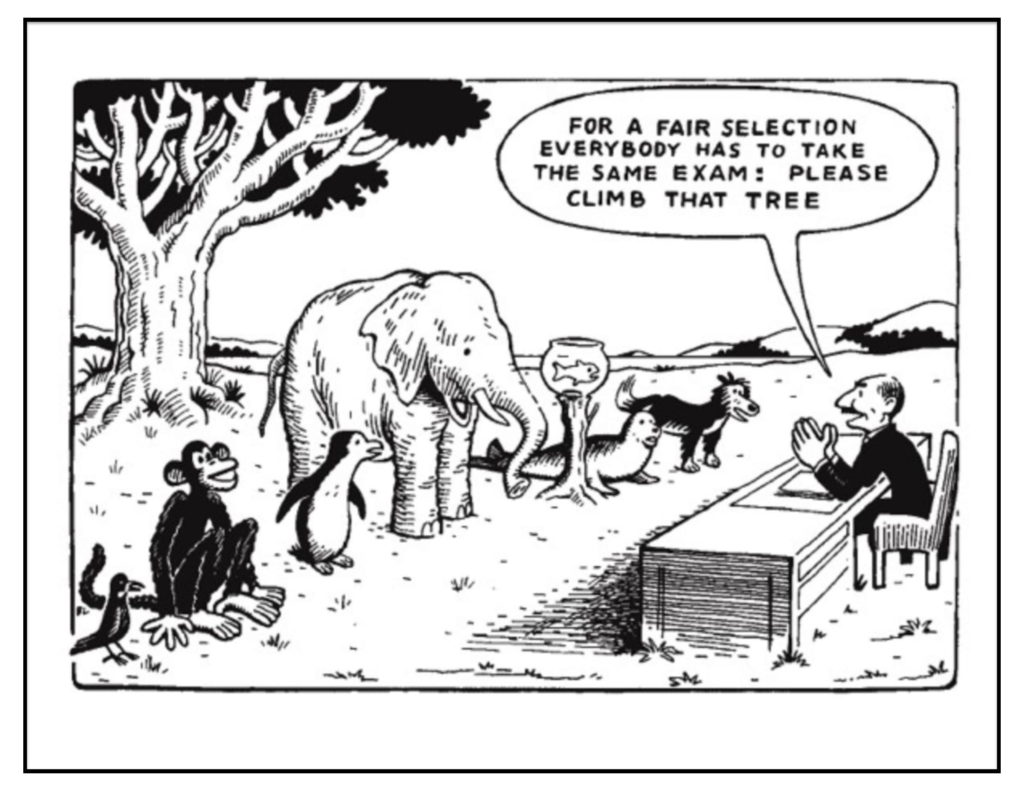
Accommodations are so important for our dyslexic learners. As I mentioned, they are bright and deserve to have access to the same information and learning opportunities. As teachers, we still want to remediate to teach these kids to read, but we also need to accommodate in the meantime to make sure they are able to grow as a learner in other areas.
Free Informational Resource
Want these myths and facts all on one page to share with parents and teachers? Click here to join my email list where you will get this free printable and loads of other exclusive free resources!
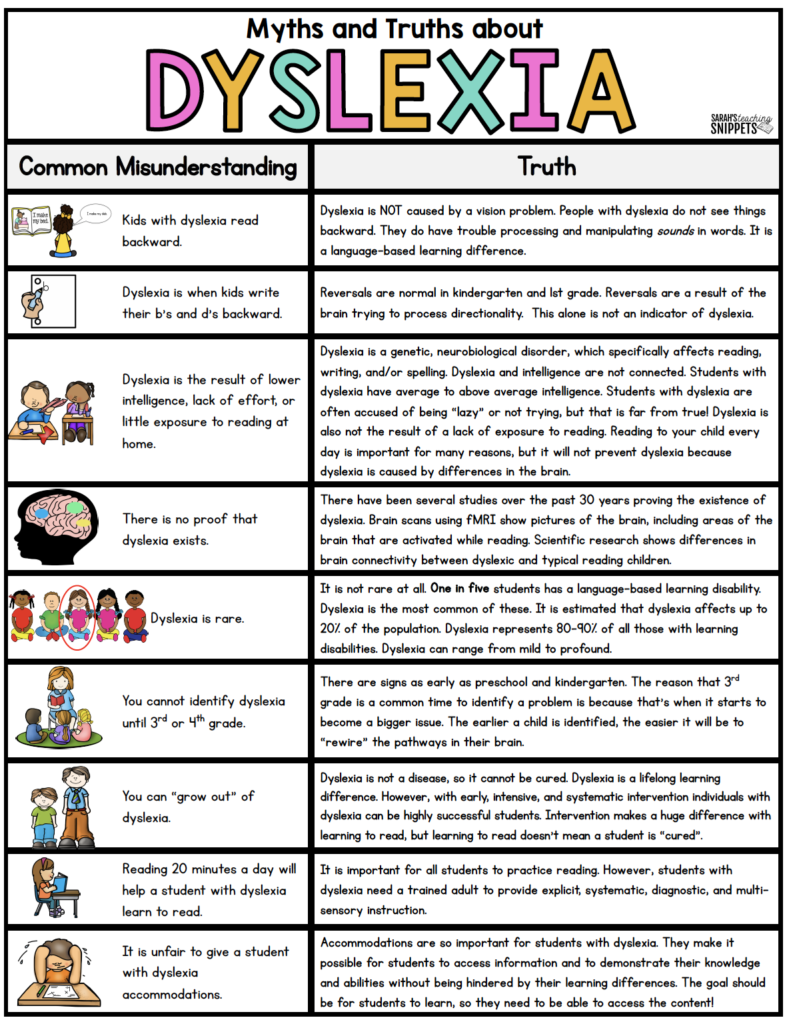
I also have these as individual slides that i will also share in the same file. Feel free to use the slides to present this information.
I hope this post was informative and helpful!
Related Posts
If you want to read more about dyslexia, I have more posts that you may be interested in reading.
